Introduction
 The Asian Classics Institute (ACI) was founded in 1993 by Geshe Michael Roach, for the purpose of sharing the contents of the ancient “Master of Buddhism” (Geshe) course with women and men of the modern world.
The Asian Classics Institute (ACI) was founded in 1993 by Geshe Michael Roach, for the purpose of sharing the contents of the ancient “Master of Buddhism” (Geshe) course with women and men of the modern world.
The Institute offers, among many other materials, 18 ACI Foundation Courses and 18 ACI Advanced Courses. The purpose of this document is to summarize the content and flow of these 36 courses. The course content consists solely of 6,800 pages of original translations of authentic, classical ancient Buddhist literature. Every page includes the complete original ancient Tibetan, to insure complete accuracy. This is the first time that most of this material has been made available in the modern world.
Geshe Michael received the great majority of this training from his Tibetan root lama, Khen Rinpoche, Geshe Lobsang Tharchin (1921-2004, shown at left). Khen Rinpoche was a great master who served as abbot of Sera Mey Tibetan Monastery, which was founded in 1419 and is one of the largest Buddhist monasteries in the world.
The geshe course requires 20 to 25 years of study to complete in a modern Tibetan monastery; Geshe Michael graduated with his geshe degree at Sera Mey in 1995. The course follows the tradition of Je Tsongkapa (1357-1419), a prolific writer and organizer whose teachings on every important aspect of Buddhism are highly accurate and—when put into personal practice—lead to the end of pain, and the goal of highest happiness, for ourselves and all other living beings.
The geshe course covers the five major topics of Buddhism; these five relate to the four great Buddhist schools of ancient India. Each school of thought is derived from the historical teachings of the Buddha, and each presents the path to enlightenment in a slightly different way—to fit disciples of different capacities and personalities.
The five great topics of Buddhism
Here is a brief description of the five topics which also connects them to the four classical schools:
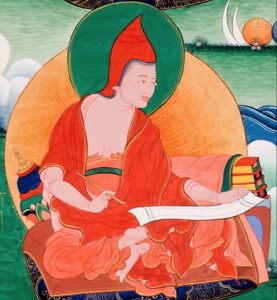 The “higher knowledge” teachings are a compilation, made by the generations immediately following the Buddha, of the great ideas he presented during his 50 years of teaching in this world.
The “higher knowledge” teachings are a compilation, made by the generations immediately following the Buddha, of the great ideas he presented during his 50 years of teaching in this world.
We can consider them the basic foundation underlying all Buddhism; and thus the Higher- Knowledge School represents the first major period of the four classic schools of Buddhist history after the Buddha.
In the geshe course, each of the five major schools is studied through one major text, which is often committed to memory. For Higher Knowledge, we study the Treasure House of Higher Knowledge, which was written by Master Vasubandhu (seen here) around 350AD. Each of these major classics is studied along with very detailed monastic textbooks which are themselves extremely important Buddhist classics, and normally date from about 500 years ago.
 One of the cornerstones of Buddhism is committing not to harm other living beings. The study of formal ethical commitments is the second great topic of historical Buddhism, and may be considered an offshoot of the Higher-Knowledge School of ancient India.
One of the cornerstones of Buddhism is committing not to harm other living beings. The study of formal ethical commitments is the second great topic of historical Buddhism, and may be considered an offshoot of the Higher-Knowledge School of ancient India.
In the geshe course, vowed morality is studied with A Short Book on Vowed Morality, written by Master Gunaprabha (at left) around 550AD.
3) Clear Thinking (Pramana)
 When we look at a box with four wheels, how is it that we see a car? How can clear thinking—call it “logic”—act as a kind of “third eye” that allows us to see deep ideas: those things we could never perceive just with our eyes and ears? These questions are covered by the third great topic of Buddhism: clear thinking, also called “accurate” or “valid perceptions.”
When we look at a box with four wheels, how is it that we see a car? How can clear thinking—call it “logic”—act as a kind of “third eye” that allows us to see deep ideas: those things we could never perceive just with our eyes and ears? These questions are covered by the third great topic of Buddhism: clear thinking, also called “accurate” or “valid perceptions.”
This topic is related to the Sutrist School, the second of the four great schools of ancient India. This school gets their name from the fact that they believe that a direct study of the original sutras or teachings of Lord Buddha is preferred to studying the summaries compiled by human beings in the Higher-Knowledge School.
The topic of clear thinking is covered in the geshe course through the study of A Commentary on Valid Perception, written by Master Dharmakirti (shown here, in debate mode) around 650AD.
4) The Perfection of Wisdom (Prajna Paramita)
The phrase “perfection of wisdom” can refer to a huge collection of original teachings by Lord Buddha; but among the five classical topics it refers to the teachings of the lower half of the Middle- Way School, which itself is the highest of the four ancient schools. This lower half is called the “Independent” Group, based on their belief in the independent power of logic and words.
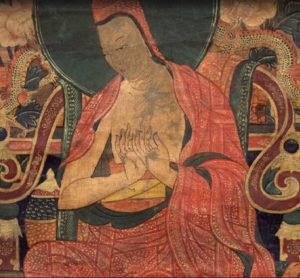 The monastery course on this topic can be considered a review of almost all the great subjects of Mahayana Buddhism: the Greater Way, the way of the bodhisattva who commits to achieve enlightenment so that they can serve all living beings. The course is structured around three great states of realization: the perception of no-self by a practitioner of the lower way; the perception of true emptiness by a bodhisattva; and the omniscience of an enlightened being.
The monastery course on this topic can be considered a review of almost all the great subjects of Mahayana Buddhism: the Greater Way, the way of the bodhisattva who commits to achieve enlightenment so that they can serve all living beings. The course is structured around three great states of realization: the perception of no-self by a practitioner of the lower way; the perception of true emptiness by a bodhisattva; and the omniscience of an enlightened being.
This fourth topic is covered by using the Jewel of Realizations dictated to Master Asanga (seen here, around 350AD) by Lord Maitreya, the Coming Buddha. As with all the other topics, but especially in this case, the course also includes a huge amount of commentary, the greatest of the classics of Tibet.
In addition to these works, there is a monastery tradition to “extract” important subjects from the Jewel and create entire genres of literature based on them. In fact, the first use of the Asian Classics Input Project’s (ACIP) data to print books for use in modern monasteries was to make a collection of these “extracted” works available again for the first time. Whole books are devoted, for example, to the twelve links of dependent origination; and to the third of the four great schools: the Mind-Only School.
5) The Middle Way (Madhyamika)
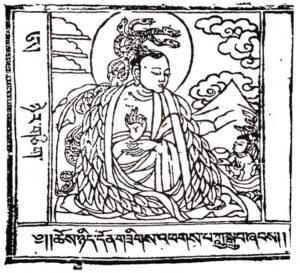 The fifth and final great topic is called “Middle Way,” which in the geshe course outline actually refers only to the higher half of this highest of the four schools, itself also called “Middle-Way School”—so that can be a little confusing. This higher half is the Consequence Group, so called because of their belief in the unique power of pointing out to people the absurd consequences of their mistaken ideas.
The fifth and final great topic is called “Middle Way,” which in the geshe course outline actually refers only to the higher half of this highest of the four schools, itself also called “Middle-Way School”—so that can be a little confusing. This higher half is the Consequence Group, so called because of their belief in the unique power of pointing out to people the absurd consequences of their mistaken ideas.
This topic is covered using Entering the Middle Way, an explanation of the matchless thinking of Arya Nagarjuna (200AD, shown above) by Master Chandrakirti (shown next), who lived around 650AD.
The structure of this book is to follow the ten bodhisattva levels, which are themselves built upon the six perfections, or typical activities of a bodhisattva. The chapter on the sixth bodhisattva level, which focuses on the perfection of wisdom and thus the direct perception of emptiness, is the vast majority of the book.
“Middle Way” in the geshe course therefore focuses upon the highest teachings on emptiness, and how to see it directly. Since the viewpoint on emptiness held by this higher half of the highest school is perfectly correct, other great traditions of teaching and practice are built on it.
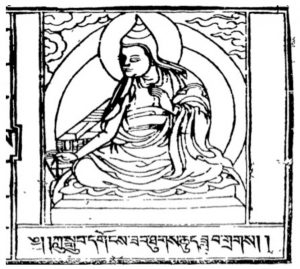 Most important among these is the Diamond Way tradition of advanced teaching and practice, which is designed to bring a person to enlightenment within a single lifetime—much faster than the many millions of years otherwise required.
Most important among these is the Diamond Way tradition of advanced teaching and practice, which is designed to bring a person to enlightenment within a single lifetime—much faster than the many millions of years otherwise required.
The tradition on the “steps of the path,” or the famous lam-rim, is also built upon this higher Middle-Way School. The lam-rim tradition has been described as a presentation of the five great topics, based on the fifth, which has been abbreviated and simplified for people who don’t have time for or attraction to a meticulous study of the five great topics.
Another important tradition built on this last topic is known as the “art of interpretation,” which also often ties into yet a tradition known as “a survey of the schools of philosophy.” Together these involve interpreting all the major schools of thought in ancient India—both Buddhist and non-Buddhist; especially on issues relevant to understanding emptiness.
Deeper details of the very important Mind-Only School are studied by aspiring geshes in the context of this art of interpretation.
Organized by “track,” the first two ancient schools (Higher-Knowledge and Sutrist) are grouped into the “lower way,” where disciples have not yet built up to the bodhisattva motivation to achieve enlightenment to help all beings; and the Higher Way. The third and fourth ancient schools (Mind-Only and Middle-Way) then are grouped into the higher way (“Mahayana” in Sanskrit). The distinction between these two ways, on a deeper level, depends upon the precision with which they explain the concept of emptiness.
The geshe curriculum and the five great topics
Here is a summary of the order and length of the geshe studies for the five great topics in a typical Tibetan monastery of the Tsongkapa lineage (this can differ somewhat from monastery to monastery).
Year 1–Year 12
Perfection of Wisdom
Year 13-Year 16
Middle Way
Year 17–Year 18
Vowed Morality
Year 19–Year 20
Higher Knowledge
Year 21–Year 25
Additional studies, such as the art of interpretation, depending on geshe examination schedule
Every year, 3 months in winter
Clear Thinking, through intense intermonastic debating sessions
The 18 ACI Foundation Courses compared to geshe curriculum and the five great topics
Now that we have some background on the five great topics, let’s see how the 18 Foundation Courses of the ACI curriculum present these topics.
ACI Foundation Course 1: The Principal Teachings of Buddhism
ACI Course 1 is a thorough study of the three great realizations (commonly known as the “three principal paths”) needed by every practitioner of Buddhism—which is why it’s the first of the 36 courses. These three are:
-
- renunciation, or dismay at the pain of the world;
- the Wish for enlightenment, or wanting to become a Buddha
ourselves so that we can help every living being in the universe; and - a correct view of the world, or seeing that there is no person, and no object, which does not come the seeds in my own mind.
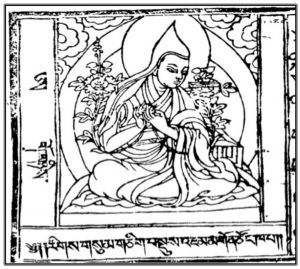 This course is founded in the fifth topic, Middle Way. It relies on a very famous poem by Je Tsongkapa (shown here), itself entitled The Three Principal Paths. The course also contains the complete text of a jewel of a commentary upon this poem by Pabongka Rinpoche (1878-1941), the most illustrious Tibetan lama of the early 20th century, and root teacher of Trijang Rinpoche (1901-1981), root teacher of Khen Rinpoche Geshe Lobsang Tharchin.
This course is founded in the fifth topic, Middle Way. It relies on a very famous poem by Je Tsongkapa (shown here), itself entitled The Three Principal Paths. The course also contains the complete text of a jewel of a commentary upon this poem by Pabongka Rinpoche (1878-1941), the most illustrious Tibetan lama of the early 20th century, and root teacher of Trijang Rinpoche (1901-1981), root teacher of Khen Rinpoche Geshe Lobsang Tharchin.
ACI Foundation Course 2: Buddhist Refuge
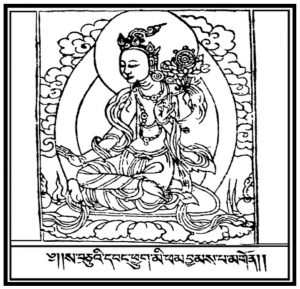 Accurately taking refuge in the Buddha is said to be the one single act that makes any person a Buddhist. And so the next ACI course explores how we do this: how we seek protection from the pain of life, within our heart. Incidentally we cover other important ideas of Buddhism associated with refuge: the Wish for enlightenment, the bodhisattva, nirvana, emptiness, and Buddhahood itself.
Accurately taking refuge in the Buddha is said to be the one single act that makes any person a Buddhist. And so the next ACI course explores how we do this: how we seek protection from the pain of life, within our heart. Incidentally we cover other important ideas of Buddhism associated with refuge: the Wish for enlightenment, the bodhisattva, nirvana, emptiness, and Buddhahood itself.
This course is founded in the fourth topic—the Perfection of Wisdom—and includes readings from commentaries upon the Jewel of Realizations composed by the future Buddha, Maitreya (shown here), with Arya Asanga (c. 350AD). These commentaries were written by Kedrup Tenpa Dargye (1493-1568), an esteemed author of textbooks for the geshe curriculum at Sera Mey Tibetan Monastery.
ACI Foundation Course 3: Applied Meditation
Good meditation is the foundation of all Buddhist practice, and so the next ACI course presents meditation in the Tsongkapian tradition: a precise, effective science with a solid lineage of many centuries behind it—as opposed to many of the poorly-founded meditation fads that come and go in the world today.
In this course we delve into this science, and this lineage, to create a strong foundation for a personal meditation practice that we can apply to our whole life, whether at home or in our professional career.
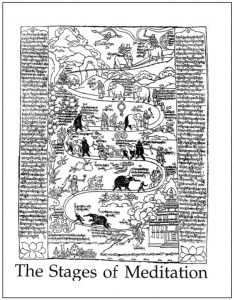 The centerpiece of this course is a special woodblock carving called “The Stages of Meditation” (seen at left). This poster presents an entire course in meditation and was designed by Kyabje Trijang Rinpoche based upon the teachings of the Indian master Kamalashila (c. 775AD), whose 3-part Stages of Meditation is the foundation of all later schools of meditation in Tibet. The course further relies heavily upon the very detailed presentation of this system given by Je Tsongkapa in his major works on the steps of the path.
The centerpiece of this course is a special woodblock carving called “The Stages of Meditation” (seen at left). This poster presents an entire course in meditation and was designed by Kyabje Trijang Rinpoche based upon the teachings of the Indian master Kamalashila (c. 775AD), whose 3-part Stages of Meditation is the foundation of all later schools of meditation in Tibet. The course further relies heavily upon the very detailed presentation of this system given by Je Tsongkapa in his major works on the steps of the path.
A robust meditation practice lies behind every one of the five major topics of Buddhism, especially the Middle Way—which says that enlightenment is only possible through a combination of deep meditation (called shamatha in Sanskrit) and deep insight into emptiness (correctly spelled vipashyana).
ACI Foundation Course 4: The Proof of Future Lives
Successful Buddhist practice depends on true compassion, which itself depends on accurately perceiving the massive scope of the world’s pain— which extends beyond the life we are experiencing right now. Thus the topic of the next ACI course: the proof of future lives.
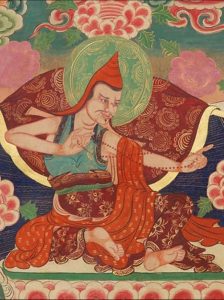 Very few people in the modern world believe that they have come from a past life into this life, or that they will proceed from this life into another, for time with no beginning or end. If the whole purpose of Buddhism is to destroy suffering and insure happiness in all of these countless lifetimes, it would help first of all to prove that they actually exist. This is what ACI Course 4 undertakes to do.
Very few people in the modern world believe that they have come from a past life into this life, or that they will proceed from this life into another, for time with no beginning or end. If the whole purpose of Buddhism is to destroy suffering and insure happiness in all of these countless lifetimes, it would help first of all to prove that they actually exist. This is what ACI Course 4 undertakes to do.
For this course we utilize the third great topic— Clear Thinking, since one of the first purposes this topic is for establishing the existence of our past & future lives. We also delve into some additional, related topics here—such as the levels of reality; the definition of valid perception; proofs for the existence of omniscience itself; and the connection between karma & rebirth.
For ACI Course 4 we rely heavily on the root text by Master Dharmakirti— A Commentary on Valid Perception; as well The Jewel of the True Thought, an extraordinary commentary to this difficult work composed by the modern Tibetan sage Geshe Yeshe Wangchuk (1928-1999). This is the root lama of one of Geshe Michael’s most important teachers in the monastery, Geshe Thupten Rinchen; and Geshe Michael assisted both Geshe Rinchen and Geshe Wangchuk himself in the editing of the work. We also get a little peek into the work of Master Dignaga (c. 550AD, and shown here), who was the master behind Master Dharmakirti.
ACI Foundation Course 5: How Karma Works
If karma has created our world, and ourselves, then we need to know exactly how it works if we want to change this world, and ourselves. Thus the next ACI course.
This is equally important if we grew up in a culture that never believed in karma; or a culture that did believe in it, but perhaps not very accurately. ACI Course 5 is an excellent summary of the classical teachings on every major aspect of how karma works.
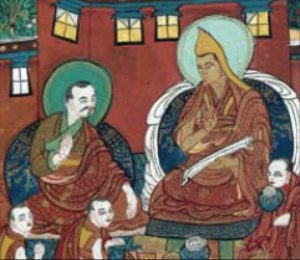 The great traditional source for the teachings on karma is the Treasure House of Higher Knowledge, by Master Vasubandhu, on the first of the great topics, and from the first of the four great schools.
The great traditional source for the teachings on karma is the Treasure House of Higher Knowledge, by Master Vasubandhu, on the first of the great topics, and from the first of the four great schools.
In this course, we delve into this treasure with the helping hand of Light on the Path to Freedom, a great introductory commentary upon Master Vasubandhu’s work by Gyalwa Gendun Drup (1391-1474). This master was a direct student of Je Tsongkapa, and we see them here in a traditional painting of their first meeting. Here in Course 5 we also get a foretaste of how emptiness and karma work together, using some selections of Middle-Way literature.
ACI Foundation Course 6: The Diamond Cutter Sutra
Before we get too deeply into the 36 ACI courses, it’s essential for us to get a good “hit” of the all-important concept of emptiness, presented in its highest and most accurate form within the fifth great topic of the Middle Way. Understanding this emptiness is, according to the Buddha, the only way we can help ourselves and every other living being out of pain.
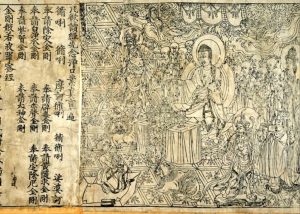 Although in the Western world we might normally think of the Bible as the most printed and influential book of all time, this honor may actually go to the Diamond Cutter Sutra: here we see a Chinese woodblock edition, which is the oldest printed book in the world with a publication date inside (868AD).
Although in the Western world we might normally think of the Bible as the most printed and influential book of all time, this honor may actually go to the Diamond Cutter Sutra: here we see a Chinese woodblock edition, which is the oldest printed book in the world with a publication date inside (868AD).
The sutra, as is typical, is actually a conversation between Lord Buddha and one of his disciples, who has asked a question that triggers and entire teaching. Only one major commentary to the Diamond Cutter survives from ancient India; and a second extremely important Tibetan commentary was recovered by the Asian Classics Input Project (ACIP), founded by Geshe Michael at Princeton University in 1987. This project has recovered, digitalized, and made available free online millions of pages of ancient Buddhist texts.
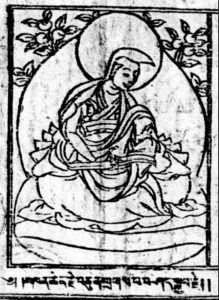 This commentary is called Sunlight on the Path to Freedom and was written Drakpa Shedrup (popularly known as Choney Lama and seen here in a traditional woodblock carving), who lived 1675-1748. He was an important writer of textbooks for the geshe course at Sera Mey Monastery and has contributed over 250 very accurate and insightful explanations of the greatest teachings of Buddhism. This sixth ACI course presents the cream of the great ideas from his commentary on the Diamond Cutter: a complete primer on emptiness.
This commentary is called Sunlight on the Path to Freedom and was written Drakpa Shedrup (popularly known as Choney Lama and seen here in a traditional woodblock carving), who lived 1675-1748. He was an important writer of textbooks for the geshe course at Sera Mey Monastery and has contributed over 250 very accurate and insightful explanations of the greatest teachings of Buddhism. This sixth ACI course presents the cream of the great ideas from his commentary on the Diamond Cutter: a complete primer on emptiness.
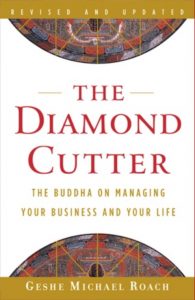 The sutra and Choney Lama’s commentary provided the foundation for Geshe Michael’s popular business and personal success book, The Diamond Cutter: The Buddha on Managing Your Business & Your Life, which has sold around a million copies and is found in more than 30 languages worldwide. This in turn became the foundation of the Diamond Cutter Institute (DCI), which now provides success training to about 30,000 people per year, in some 20 countries.
The sutra and Choney Lama’s commentary provided the foundation for Geshe Michael’s popular business and personal success book, The Diamond Cutter: The Buddha on Managing Your Business & Your Life, which has sold around a million copies and is found in more than 30 languages worldwide. This in turn became the foundation of the Diamond Cutter Institute (DCI), which now provides success training to about 30,000 people per year, in some 20 countries.
ACI Foundation Course 7: The Vows of the Bodhisattva
If understanding emptiness is the car that gets us to enlightenment, then the Wish to help all the living beings in this universe is like the fuel for the car. Thus the next ACI course, which is a careful presentation of the traditional 64 commitments that we make and keep, in order to turn ourselves into a working bodhisattva.
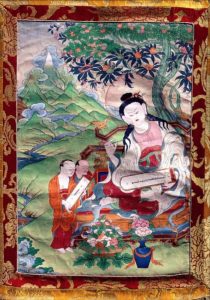 We learn both the details of the vows and the ancient sources from which they came. These include the Buddha himself; Master Chandragomi (seen here); Arya Asanga; and Master Shantideva.
We learn both the details of the vows and the ancient sources from which they came. These include the Buddha himself; Master Chandragomi (seen here); Arya Asanga; and Master Shantideva.
The description of the vows themselves is based upon two important commentaries. The first is A Highway for Bodhisattvas, Je Tsongkapa’s extensive, definitive explanation of the commitments and their sources. The second is A String of Shining Jewels, a incredible jewel which perfectly summarizes each commitment of the three sets of vows—those of personal freedom; the bodhisattva vows; and the secret commitments—in a clear but concise way. This work is another that was recovered by ACIP, and was composed by Geshe Tsewang Samdrup of Drepung Tibetan Monastery in the 1800’s.
The bodhisattva vows relate especially to the fifth and highest of the five topics: the Middle Way.
ACI Foundation Course 8: Death & the Realms of Existence
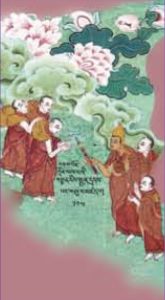 The possibility of future lives opens up the question of just what realms there are in the universe that we could end up going to after our death. And then there is the whole question of the death process itself: Just what happens to us? There seems to be little “hard” information about it, and perhaps a lot of misinformation.
The possibility of future lives opens up the question of just what realms there are in the universe that we could end up going to after our death. And then there is the whole question of the death process itself: Just what happens to us? There seems to be little “hard” information about it, and perhaps a lot of misinformation.
In this eighth course of the ACI foundation series, we go straight to the most authentic, ancient sources to answer these questions. We rely heavily on the first topic, the teachings on Higher Knowledge, again using Master Vasubandhu’s root text and the commentary by Tsongkapa’s illustrious student Gyalwa Gendun Drup.
We supplement these with a very important, early work from the 12th century entitled The Great Book on the Steps of the Teaching. This huge text, composed by Geshe Drolungpa, Lodru Jungne, was recovered and printed by ACIP—and is the longest surviving work from the important Kadampa era of early Tibetan Buddhism. Interestingly, the manuscript had also been lost in Tsongkapa’s time, and he also rediscovered it! The traditional painting here shows the joyful scene.
ACI Foundation Course 9: The Ethical Life
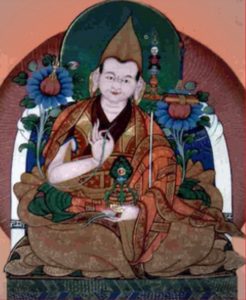 The foundation of all karma, and the rocket booster that carries us to our next life, consists of the seeds that we plant as we are kind or unkind to those around us, on a daily basis. The Buddha spent much of his life clarifying which of these seeds are most important, most powerful—and so it’s extremely important for us to learn these details.
The foundation of all karma, and the rocket booster that carries us to our next life, consists of the seeds that we plant as we are kind or unkind to those around us, on a daily basis. The Buddha spent much of his life clarifying which of these seeds are most important, most powerful—and so it’s extremely important for us to learn these details.
And so the next, the ninth, foundation course of ACI is devoted exclusively to the second of the five great topics: vowed morality. We present the entire structure of Buddhist commitments to an ethical life, known as the “vows of individual freedom” since those who keep them attain nirvana, whereas those who don’t do not.
This presentation is based upon an extremely famous poem by Je Tsongkapa entitled The Essence of the Ocean, and a wonderful commentary to it by Master Quicksilver, Ngulchu Dharma Bhadra (1772-1851, seen here).
Master Quicksilver is a crucial part of our own Diamond Way lineage and will appear often in the 18 advanced courses of ACI. The fact that he also contributed important works on Buddhist morality is an indication of how important the ethical life is for those who hope to reach enlightenment in a single lifetime, using the Diamond Way.
Je Tsongkapa also wrote a legendary epistle revealing the connection between keeping to an ethical life and success in trying to meditate—and this is an important part of this course. The epistle was written, in fact, to his close disciple Tsako Wunpo, Ngawang Drakpa—the same one for whom the Master wrote The Three Principal Paths that are the subject of ACI Foundation Course 1.
ACI Foundation Course 10: A Guide to the Bodhisattva’s Way of Life, Part 1
 The geshe course is not all classes, memorizing, and debates. An important part of every aspiring geshe’s life is the teaching they receive, often upon important texts outside of those covered in the geshe course, by the greatest living masters of their time. These masters are invited several times a year to visit every major monastery, and deliver such teachings in a lecture series that may go on all day for a week or even a month.
The geshe course is not all classes, memorizing, and debates. An important part of every aspiring geshe’s life is the teaching they receive, often upon important texts outside of those covered in the geshe course, by the greatest living masters of their time. These masters are invited several times a year to visit every major monastery, and deliver such teachings in a lecture series that may go on all day for a week or even a month.
These extracurricular teachings tie together all the five topics of the historical traditions into a living, personal practice for these young scholars. A very typical series will be devoted to A Guide to the Bodhisattva’s Way of Life, composed by the ultimate bodhisattva, Master Shantideva (700AD, shown here).
This text, one of the greatest classics of the Middle Way (fifth great topic), first covers the details of developing the Wish for enlightenment; methods for accumulating powerful seeds to practice this path; and then the six perfections, or activities to be mastered by every bodhisattva.
Master Shantideva’s presentation of these six is considered perhaps the greatest of all time. Their inclusion into no less than three of the 18 ACI Foundation Courses is meant to catapult us from the theory of the geshe course into a profound personal practice of these ideas.
Here in the tenth course, we cover the Wish for enlightenment itself (called bodhichitta in Sanskrit); preliminaries to practice; and the first two of the perfections: giving, and the ethical life, in the context of a bodhisattva’s practice of emptiness and compassion.
ACI Foundation Course 11: A Guide to the Bodhisattva’s Way of Life, Part 2
In this course we continue with Master Shantideva’s primer on the six activities of a bodhisattva, covering the next three perfections: patience, joyful effort, and meditation. The Master’s presentations here are simply among the most stunning of all the 25 centuries of Buddhism in this world.
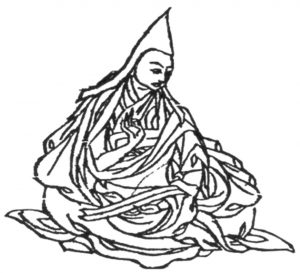 In addition to the original verses of his guide for bodhisattvas, each of the three courses on Shantideva’s work includes the relevant commentary by Gyaltsab Je, Darma Rinchen (1364-1432, shown here).
In addition to the original verses of his guide for bodhisattvas, each of the three courses on Shantideva’s work includes the relevant commentary by Gyaltsab Je, Darma Rinchen (1364-1432, shown here).
Gyaltsab Je was already a renowned Buddhist philosopher before he became a student of Je Tsongkapa; he then devoted himself completely to the Master, and became the first holder of his throne and keeper of his teachings—the position of the Ganden Tripa, which continues to this day. His prose commentary surrounds Shantideva’s lines of poetry like a gold setting for a perfect diamond.
ACI Foundation Course 12: A Guide to the Bodhisattva’s Way of Life, Part 3
The third course of Master Shantideva’s Guide is devoted almost exclusively to the sixth and greatest of the perfections of the Middle Way: the perfection of wisdom, the perception of emptiness.
The verses found here are, again, considered some of the greatest emptiness teachings of all time, clarifying many of the thorny questions about this ultimate reality which have been asked for thousands of years.
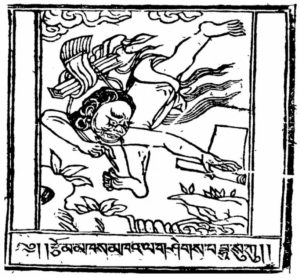 Tradition says that as he covered these final lines in the original teaching of his text, many of Shantideva’s emptiness concepts literally “went over the heads” of his listeners—a number of them monks who had previously dismissed him as a bhusuku, or lazybones. At this point, Shantideva rose into the sky in a wrathful mode (seen here in a traditional carving)—and a team of monks had to be sent far and wide to locate him, and the rest of his text!
Tradition says that as he covered these final lines in the original teaching of his text, many of Shantideva’s emptiness concepts literally “went over the heads” of his listeners—a number of them monks who had previously dismissed him as a bhusuku, or lazybones. At this point, Shantideva rose into the sky in a wrathful mode (seen here in a traditional carving)—and a team of monks had to be sent far and wide to locate him, and the rest of his text!
The final class of the course includes a selection from the famous “Dedication Chapter” of Shantideva’s work, where he dedicates the goodness of his composition to providing direct comfort to every kind of being in the universe experiencing any kind of pain, right now—from beings in the hell realms to women in labor, to birds wending through the empty sky.
ACI Foundation Course 13: The Art of Reasoning
A carpenter who wants to build a house needs the tools of their trade: hammer, saw, and square. Anyone who wants to reach enlightenment must learn ways of seeing things that cannot be seen with our eyes, or even in normal states of mind. This is why we learn meditation, and this is why we learn the art of reasoning: the core of the third great topic, clear thinking.
This too is why aspiring geshes in the Tsongkapian tradition spend three months every year sharpening their logic and debating skills, often at the month-long intermonastic Olympics known as the “Winter Debates.” Here, teams of the best of the best from each monastery go at it on the debate ground, all day and often long into the night.
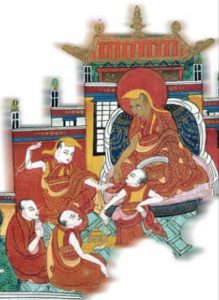 This tradition of questioning and exploring the great ideas of Buddhism together goes back to Lord Buddha himself, and is crucial to the Tsongkapa method of learning (we see Je Rinpoche himself here as a young monk learning debate). It first of all gives a geshe the tools to evaluate new ideas critically, and come to an airtight understanding of which are correct, and which are, ultimately, useless—like fire extinguishers sold at a discount store, that don’t work when you have an urgent need for them: say, at the moment of death.
This tradition of questioning and exploring the great ideas of Buddhism together goes back to Lord Buddha himself, and is crucial to the Tsongkapa method of learning (we see Je Rinpoche himself here as a young monk learning debate). It first of all gives a geshe the tools to evaluate new ideas critically, and come to an airtight understanding of which are correct, and which are, ultimately, useless—like fire extinguishers sold at a discount store, that don’t work when you have an urgent need for them: say, at the moment of death.
Secondly, this custom of intense and critical debate makes a geshe both accurate and fearless when they need to answer their own students’ questions, as they later become a teacher in their own right. Finally, the annual interaction of the best geshe candidates from every major monastery strengthens the Tsongkapian monasteries themselves—as these buddhing geshes are the people who will become the abbots and debate masters of their own monasteries, decades later.
Monks in these monasteries undertake their first studies in reasoning and debate around the age of 15, tackling one of the traditional monastic summaries of Master Dharmakirti’s greatest ideas. For this course, we have used one of the greatest of these, written by Purbuchok Jampa Gyatso (1825- 1901), an important figure in our immediate lineage, passed down to us by Khen Rinpoche.
This work is entitled An Explanation of the Path of Reasoning, and belongs to a genre of literature known as dura, or the “collected topics” of clear thinking. Included in these texts, and in the course here, are not just exquisite explanations of the ancient forms of Buddhist logic, but also essays—in debate format—on crucial topics such as the definition and divisions of existence; cause & effect; negatives & positives, and the all-important quality & characteristic.
A mastery of each of these topics is essential for the ultimate task of seeing emptiness directly; and thus the study of this third of the great topics, clear thinking, is traditionally called “the key to emptiness.” We can see for example how this course is a cornerstone for DCI Level 7, devoted to “Touching the Diamond World.”
ACI Foundation Course 14: Lojong: Developing the Good Heart
The next ACI foundation course focuses on a thousand-year-old tradition known as lojong, which literally means to practice the state of mind—meaning methods of developing the Wish for enlightenment, here called “the good heart.”
We take a complete about-face from the highly technical material of Buddhist logic and perceptual theory, into an elite sampler of the most sublime poems of the lojong tradition. Our readers might be surprised to learn that one of the reasons for inserting the study of the good heart at this point in the foundation courses was to encourage students in the original series of teachings who had found the previous course a bit overwhelming!
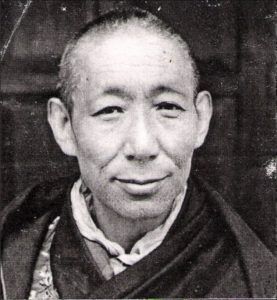 We travel through seven of the most famous examples of the lojong literature, including first of all the famed Eight Verses for Developing the Good Heart, composed by the Kadampa master Diamond Lion (1054-1123). This is an extremely popular, practical piece on compassion and voidness often taught by visiting lamas when they are limited to a single talk or two.
We travel through seven of the most famous examples of the lojong literature, including first of all the famed Eight Verses for Developing the Good Heart, composed by the Kadampa master Diamond Lion (1054-1123). This is an extremely popular, practical piece on compassion and voidness often taught by visiting lamas when they are limited to a single talk or two.
Here also you will find the famed Seven Points for Developing a Good Heart, an oral tradition which was put into its final form by the Kadampa geshe Chekawa, Yeshe Dorje (1101-1175).
A final principal work in this tradition included in the course is The Crown of Knives, composed by the Indian master Dharma Rakshita and presented to his disciple Lord Atisha (982-1052) as he bravely departed over the Himalayas to help bring some of their first teachings on Buddhism to the Tibetan people. This lojong text is famed for its presentation on karmic correlations (“do this, get that”); and was a primary source for the modern version of these correlations presented by Geshe Michael in the Diamond Cutter business success book.
The only reason we still have originals of lojong materials from ancient Tibet is the devoted labor to assemble them by Trijang Rinpoche, Lobsang Yeshe Tendzin Gyatso (1901-1981, seen here), root lama of Khen Rinpoche and not only a passionate preserver of the ancient books, but a true example of the good heart.
ACI Foundation Course 15: What the Buddha Really Meant
A fascinating fact of the life of the historical Buddha is that—during his teaching career in this world, which lasted some 50 years—he presented three great cycles of teachings. And these cycles seem to contradict each other!
Simply put, the Buddha spent the years just after his enlightenment acquainting his disciples with what are basically lists of important principles—for example, the four truths; the twelve links of dependence; the ten good deeds.
And then suddenly, in the second great period of his teaching on earth, the Buddha began to focus on emptiness, emphasizing how nothing in the world has any nature of its own. “Fire,” for example, “is not hot—from its own side.”
As might be expected, these lectures—typified by the famous Heart Sutra and Diamond Cutter Sutra—created an uproar among his students. In a famous exchange between the Buddha and ten of these disciples (all famous bodhisattvas), they confront him with apparent contradictions and ask him what’s up!
The Q&A sessions that came out of this triggered the third and final great period of the Buddha’s teaching career, which came to be known as “The Clarification.” The record of the conversations with the ten disciples constitutes the most famous sutra from this period, which is called— appropriately—What I Really Meant.
The interpretation of this clarification itself became the topic of heated debate in subsequent centuries, and led to the creation of the important Mind-Only School—which as we’ve noted above is studied in the geshe course primarily under the mantle of the fifth great topic, the next school up: the Middle Way.
The most famous treatment of this sutra is known as The Essence of Eloquence, by Je Tsongkapa himself, and that work forms the basis of this ACI course. This is a relatively brief presentation but is considered so essential in the monastery that aspiring geshes who commit the entire commentary to memory win a special award before the general assembly of monks.
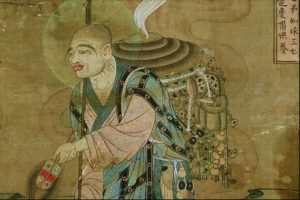 Tsongkapa’s text importantly references earlier, Chinese writings from the Tang Dynasty—including work by the famed Chinese monk Xuanzang (602- 664AD, shown here with his famous backpack) and his students. This master spent 17 years of intense study while walking through India during the peak of Buddhism there, and returned home to translate many of the great classics, including What I Really Meant.
Tsongkapa’s text importantly references earlier, Chinese writings from the Tang Dynasty—including work by the famed Chinese monk Xuanzang (602- 664AD, shown here with his famous backpack) and his students. This master spent 17 years of intense study while walking through India during the peak of Buddhism there, and returned home to translate many of the great classics, including What I Really Meant.
His disciple Master Yuance (613-696AD) has written one of the longest treatises translated into the Tibetan canon of ancient classics, upon this very sutra; and research on this work is one of the most important cornerstones of DCI’s program for modern Asian business executives entitled “China Soft Power.”
Practically speaking, this final course of the ACI Foundation Series (courses 16-18 being a review) fits into the flow of this series as a springboard for ACI students to share their newfound wisdom with others. That is, it presents the crucial concept of adjusting our message to the audience in front of us— the justification that Lord Buddha gives for presenting his message, throughout his lifetime, in a whole variety of different ways.
This is perhaps the “greatest of teaching tips” for those who are graduating from the Foundation Courses and looking forward to sharing their learning with people throughout the world, to help introduce interested persons to this wonderful spiritual path.
ACI Foundation Course 16
The final three foundation courses (numbers 16 to 18) are a review of the fifteen courses described so far. This review is meant both to consolidate the student’s understanding of this entire compact version of the traditional geshe course; and to give them a strong foundation for the upcoming 18 courses of the advanced, Diamond Way Series.
Foundation course 16 is a review of the first five foundation courses: The Principal Teachings of Buddhism; Buddhist Refuge; Applied Meditation; The Proof of Future Lives; and How Karma Works.
ACI Foundation Course 17
Foundation course 17 is a review of the middle five foundation courses: The Diamond Cutter Sutra; The Vows of the Bodhisattva; Death & The Realms of Existence; The Ethical Life; and A Guide to the Bodhisattva’s Way of Life, Part One.
ACI Foundation Course 18
Foundation course 18 is a review of the final five foundation courses: A Guide to the Bodhisattva’s Way of Life, Parts Two and Three; The Art of Reasoning; Lojong, Developing the Good Heart; and What The Buddha Really Meant.
The 18 ACI Diamond Way Courses
A review of the advanced ACI courses—the 18 Diamond-Way Courses— will be presented during the second level of the teacher training.








